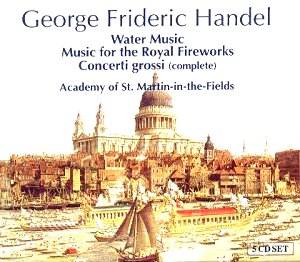This five CD set, originally recorded in 1994 for Hänssler
Classics, offers generally good accounts of the Opp. 3 and 6 Concerti
Grossi and of the Water and Fireworks music. It’s the third time that
the Academy have recorded the Op. 6 set and they still have imaginative
and enjoyable things to say even if they are no longer front runners
in this repertoire (though amongst "traditional" performances
they still hold an honoured place). There is considerable accomplishment
in the readings, technical excellence, poise and a genuinely affecting
simplicity. So for example one can admire the swaggering vigour of the
G major Allegro or the emphatic wandering bass line of that first concerto’s
succeeding Adagio. The Academy are also good at pointing up the witty
nonchalance of the final Allegro. Their approach to tempo is convincing;
things are slightly tighter here than in their earlier traversals –
the nice walking tempo of the first movement of No. 2 in F major is
a case in point – and the instrumental soloists (such as the violin
duettists in the largo of the F major) are splendid. Iona Brown introduces
oboes in Nos. 1, 2, 4 and 6, something of a departure for the Academy.
There can be demerits; I found the Andante of the E minor rather dogged
and insufficiently distinguished in terms of tempo and string weight
from the following Allegro. I also think that the third movement of
No. 4 in A minor insufficiently piano, as marked.
Still these can be counted against other equally notable
successes – the brisk decisiveness of the D major’s largo is a real
plus though the concluding movement of that Concerto seems too jog trottingly
plain. Balance is restored in the Largo affettuoso that opens No. 6
in G minor. Care and attention has been paid to orchestral weight and
to the degree of tension and motion necessary to launch it. There is
elegance and suavity – not a derogatory word in the context – in the
Musette of the same work and a sense elsewhere in the middle concertos
of gravity and energy. The cohesion of Brown and the Academy’s view
can be demonstrated by the occasionally rather grandiose hornpipe conclusion
of No. 7 and the gravity and solemnity of the adagio of No. 8 in C minor.
They certainly don’t affect to languish in these works; the larghetto
of the F major, No. 9, could easily become an exercise in tonal effulgence
but instead is sensitive without sacrificing tempo relations. The overture
of the D minor, No. 10, has a strong sense of dynamic variance even
though there is something rather too plush to the Largo e staccato of
the A major (No. 11); the solo violin in that work’s andante is excellent
and there is buoyant certainty in the allegro of No. 12 in B minor.
The balance between solo and tutti is good, the playing praiseworthy
and if in the end some of the drama of the Op. 6 Concerti may occasionally
seem missing the playing lacks nothing in spirit and drive.
The six Op. 3 Concerti replicate many of the virtues
of the better known and more extensive set. Tempi are pliant but generally
quite propulsive. Energetic and full of colour the violin and oboe (is
it Celia Nicklin?) shine out in the Allegro of the B flat minor as does
the cello and oboist once again in the beautifully expressive Largo
of No. 2. The oboist is especially distinctive with a superb control
of the arch of the music and the tonal qualities to match. There are
plenty of opportunities for instrumental finesse and colour and the
players take them happily; sometimes there are moments of distinct heaviness
but the chamber intimacy of much of the music and its parallel impulse
to the soloistic suit the Academy well. Therefore we can readily admire
the flautist in the opening largo of No. 3 in G major, the strong basses
in the Allegro of the same work and – once again – the oboe’s exquisite
unraveling of the Andante in the F major.
Which leaves the Water Music and the Fireworks. Broadly
traditional, the performances are strong but with forward moving tempi
(nothing decisively aggressive). The Academy’s recordings of this literature
have kept pace, as it were, with original instruments performances and
there’s little difference in tempi between Marriner here and, say, Pinnock.
He still imparts distinction to much of the works though his earlier
performances have maybe that extra degree of freshness that this present
one occasionally lacks.
As a 5 CD set at super budget price this collection
has genuine attractions; not least the splendid recording quality and
equally excellent orchestral playing. I enjoyed them on their own terms
and those are of a traditional orchestra phrasing flexibly and playing
with freedom but with acute awareness of the importance of motion in
these works. The incisiveness of original instruments and the ancillary
technical matters that come with their use (matters of accenting and
articulation prominent amongst them) seem not to be so relevant here.
This is a generally satisfying and successful traversal and vigorously
pleasurable.
Jonathan Woolf
